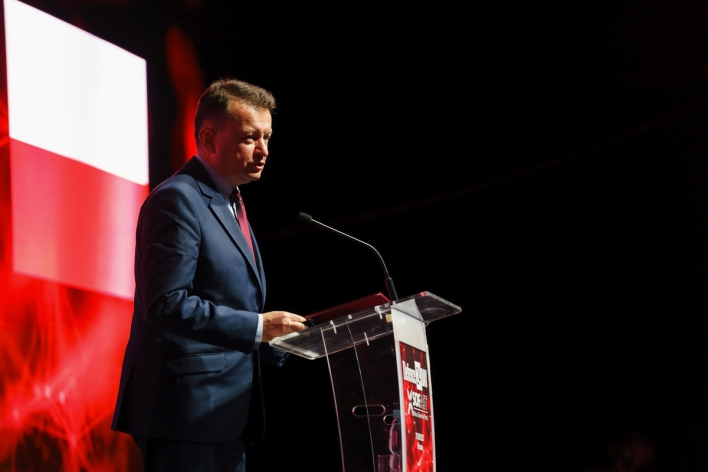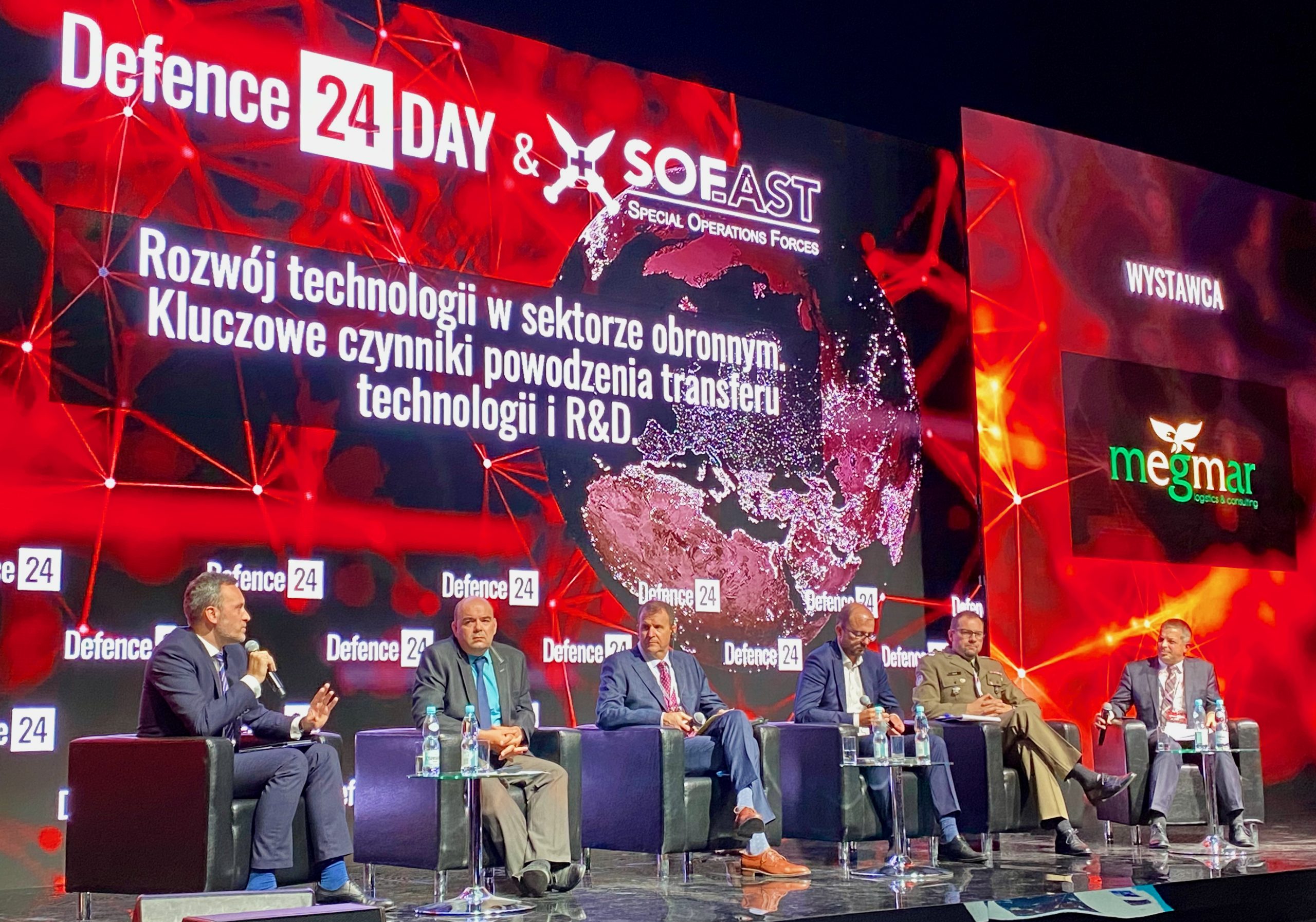By Robbin Laird
During my recent visit to Warsaw to attend the Defence 24 conference on Polish defense, I had a chance to talk with Dr. Jacek M. Raubo, an Assistant Professor at Adam Mickiewicz University in Poznań and noted journalist as well.
We discussed a number of issues regarding Polish defense and its strategic environment, and in this article, I will highlight the main themes which Dr. Raubo highlighted in the discussion.
The first and a major theme throughout was the importance of Polish history in shaping contemporary attitudes and approaches to national defense.
He argued that the Poles are deeply committed to their national defense, in a way that is not seen in most cases in contemporary Western Europe.
And I would add that, the level of commitment which can be seen in Poland currently is being seen in Europe largely in the Nordic states.
The second theme was that because of this core commitment which the Poles have to national defense, significant defense spending is not at the core of political competition in Poland.
But the approach to do so is. The current government (lead by the Law and Justice party) is committed to a more expansive and more armored enabled defense force than the opposition party, Civic Platform is. They have emphasized the need as well for more diverse capabilities for territorial defense, using lighter more mobile forces.
The third theme follows from the second but revolves around the question of the role of Germany.
The Civic Platform party when in power, followed German leads on defense. The Germans are Poland’s key economic partner, and there is a challenge for Poland in terms of how to deal with both the economic power of Germany and the military threats posed by Russia at the same time.
The fourth theme flows from the German challenge.
The embracing by the Germans of Russian energy policies, backed by the Biden Administration, is seen by the current government as a major challenge. This is viewed as well by a number of Polish analysts as part of a Russian flanking action affecting Polish defense and security as well.
The fifth theme flows from the fourth.
The Poles understand that conventional defense is not enough in today’s world where the authoritarian powers have rewritten the book on how to use security tools to challenge the cohesion of liberal democratic societies internally and in terms of their alliance structures.
Raubo underscored that there was a strong and growing commitment of Poland to working cyber defense and offense as part of the Polish capability to defend their society. He noted that cyber capabilities are being generated throughout the Polish educational and commercial structures and is becoming a core focus of Polish national defense capability as well.
The sixth theme was growing realization that the Poles do not have to sit back and cower before Russian anti-access and area denial capabilities.
They and their closest allies can go after these capabilities and challenge them in times of conflict and to work to degrade them in such conditions.
The significant commitment to air modernization via the F-35 and in terms of air and missile defense in terms of their own national programs plus adapting the U.S. IBCS system are seen as key parts of such an effort.
And associated with this is a seventh theme, namely, taking a more realistic look at Russian capabilities and countering Russian propaganda and information war about their capability’s vis a vis Poland.
We discussed the most recent Zapad exercise. In contrast to earlier periods, there was a more realistic assessment of the state of Russian forces. Rather than simply noting that the Russians deployed a large number of tanks it was underscored that most of these tanks are T-80s, and not the latest versions of Russian tanks.
Raubo cited as an example of this trend of realism the publication of a recent Polish piece on the state of the Russian Air Force. In this article, the Polish analyst argued that Russian air power was in decline. The Russians immediately responded and went out their way to attack this article directly. In other words, realistic assessment by a Pole needs to be countered by Russian information war, for the Russians want to intimate Poland.
Finally, we returned to the theme about the twin challenges of facing modern Germany and modern Russia.
Obviously, facing these two states and dealing with them is not a new situation for Poland, but the 21st century strategic context is. Germany follows a passive defense strategy vis-à-vis the Russians, and follows an economic driven approach to defense, which means that directly challenging the Russians is not part of modern Germany’s approach to power.
Such a stance is troubling for Poland who along with the Nordics see the Russians as posing a wide range of direct threats and are seen as well as in the process of ramping up the threat envelope. Raubo noted that Russia would like Poland to become more like Germany in its defense approach.
It might be noted that while visiting Poland, shortly before the Finns released their defence white paper and the Nordics announced plans for expanded operational collaboration to deal with the Russian threat.
The comment made in the recent Finnish White Paper is clearly not only believed by the Poles but is a foundation for their emphasis on defense and security modernization efforts.
Russia maintains significant conventional warfighting capabilities in Finland’s neighbouring areas and has, during the past few years, increased its military capacity in particular in its western region. It has continued the modernisation of its armed forces, and has developed their operating procedures by incorporating combat experiences from recent operations.
The ability to make rapid decisions and the high readiness of its armed forces enables Russia to carry out rapid and unexpected operations. Different methods, such as prolonging conflicts, are used to achieve desired goals. Russia has demonstrated its ability to use this wide selection of methods in a coordinated manner, with military force still playing a central role.
It would be hard to find Polish dissent from this Finnish assessment.
Dr. Jacek M. Raubo
Jacek Raubo Ph.D. (@JRaubo – Twitter account) is a security and defense expert closely collaborating with Warsaw-based “Defence24 Group”, a provider of professional websites about the military and geopolitics (Defence24.pl and Defence24.com), internal security and counterterrorism (Infosecurity24.pl), cybersecurity (Cyberdefence24.pl), space technology (Space24.pl) and energy issues (Energetyka24.com).
This group of websites is one of the biggest in the East and Central Europe region.
He also works as a senior lecturer at the Adam Mickiewicz University in Poznań.
Note: The article to which Dr. Raubo referred was written by Maciej Szopa and was published by Defence 24 on September 3, 2021.
Russian Air Force. Last Moments Before a Grand Regression
The Russian Air Force still remains the second air power globally. Nonetheless, their position is year by year, becoming weaker. Hundreds of aircraft inherited from the Soviet Union would soon be decommissioned, with no replacement in sight. Due to finances, technology, and the weaknesses of the Russian industry.
At the beginning of this year, the Russian Air-Space forces operated 380 heavy Su-27 fighter aircraft, 267 MiG-29s in a variety of variants, 131 MiG-31 interceptors, 274 Su-24, and 125 Su-34 bombers, and 193 Su-25 CAS platforms: 1370 aircraft in total. The inventory above is complemented with 124 heavy bombers (16 Tu-160, 42 Tu-95, and 66 Tu-22M), and 91 combat aircraft belonging to the Navy (22 MiG-29K/KUB, 43 Su-27/33, 22 Su-24, and 4 Su-25). This means that Russia currently operates 1585 aircraft, leading the pack and overtaking the PRC – but still being behind the US.
These numbers are far less impressive when one realizes that a certain part of this potential has been inherited from the Soviet Union. We know that the Soviet Union fell in 1991 – 30 years ago. Three decades are often defined as a term within which the expected lifecycle of MRCA comes to an end. This applies to the MiG-29 for instance – that is still being operated by Poland, to a limited extent, and with numerous challenges ahead. The manufacturing of the MiG-29 had begun in 1981. Some of the aircraft in Russian service may be 30 to 40 years old then.
The lifecycle extension process is one solution here – that may be in-depth and costly, as shown by the American example of the extension of the life cycles of the 4th generation platforms. A similar process was adopted for the fleet of 289 MiG-29s between 2009 and 2020, but only 74 aircraft underwent the procedure (24 naval fighters, and 50 land-based aircraft), including several “brand new” export aircraft that were not commissioned by Algeria, because contrary to what was agreed, Russia delivered second-hand airframes to its customer.
The above means that more than 200 of these aircraft did not undergo any works, or those works may have been limited, with their status being not much better from the 30 Polish Fulcrums, some of which have been grounded, while some are still flying, but with very limited capabilities. The replacement of the aforesaid platform may also be problematic. The MiG-35 exists.
However, only 6 examples of this aircraft have been ordered, solely to be publicly displayed as a part of the air force’s aerobatic display teams, as a marketing tool for selling the MiG-35 on the export markets. The Russians have no optimal light fighter that would meet the requirements they define. The replacement – maybe in the form of the single-engined Su-75 Checkmate – is still a plan for the distant future. No specific timeline may be mentioned here, apart from the fact that the manufacturing may be potentially launched in the 2030s.
The frontline bomber fleet is just a bit better. The Russians have managed to build 127 examples of the Su-34 over the decade (counterpart of the US-made F-15e). 296 obsolete Su-24 jets are also still operated. These aircraft were being manufactured between 1967 and 1993.
Even the youngest Fencers are reaching their thirties now. The Su-34 is not a solution here, even in a situation with another 30 jets joining the currently operated fleet soon. Even if money is available to procure more, one needs to remember that over the last decade the Russians had managed to manufacture 18 aircraft as such per year, whereas the manufacturing peaked in the mid-2010s. Only a few jets per year were rolled off the production line in recent years.
Manufacturing of the Su-30 MRCA partially fills in the capability gap expected to appear after the Su-24s are withdrawn. Only 134 examples have been built so far. Employing the Su-30 as a replacement would mean that they would not be able to carry out other missions.
The fleet of heavy fighters belonging to the Su-27 family seems to be in the best shape – relatively. During the recent decade, 134 Su-30 and 98 out of 128 procured Su-35 platforms have been manufactured. This should also include 22 modernized Su-27s – 247 aircraft in total, that may remain in the active service for a relatively long time, with satisfying availability. The Russian Air Force operates 380 Su-27 jets now.
The above means that more than 130 are legacy aircraft, that would need to be imminently replaced. 30 of them would be replaced by the not-yet-manufactured Su-35S jets. What would be used to replace the remaining 100 examples?
Theoretically – the Su-57. This would happen only if the series manufacturing of the new generation platform does not suffer from further delays. So far, 78 aircraft as such have been ordered. They are to be delivered over the upcoming 7 years. So far, a single example was handed off, even though the PAK-FA/Su-57 programme has been active since several years.
The MiG-31 interceptors’ fleet is also facing some issues. The last aircraft of the type was handed off in 1994 – it is 27 years old. The MiG-31s are upgraded to the MiG-31BM, or MiG-31K variant – the latter is a carrier platform for the Kh-37M2 Kindzhal hypersonic missile. This does not change the fact that most of those aircraft are more than 30 years old, gradually reaching the end of their lifecycle.
Only the development of a replacement platform – expected to happen within the PAK-DP/MiG-41 programme – is a viable solution here. Considering the problems emerging in the Su-57 programme, it is difficult to assess when a platform as such could be born, and whether the technical challenges, related to the engines, for instance, would be overcome
Similar circumstances also emerged in the case of the PAK-FA programme. Would proper technology be available for the PAK-DP platform (missing in the case of the Su-57 engines)? Would funds be available as well?
The CAS platforms are also in relatively bad shape – here, the Su-25 is the primary asset, 197 of which currently remain in service. Even though officially the manufacturing plant is still operational, and derivatives of the design are being offered, not a single brand new platform of the type has been delivered to the Russian Forces since 2010. Yak-130 combat trainer aircraft may be a solution here – 113 examples were delivered to the Russian Armed Forces between 2010 and 2020. However, it is far more probable that MALE UCAVs and jet UCAVs (such as the S-70 Okhotnik, utilizing a flying wing design) would replace the Su-25s.
No replacement exists for the strategic bombers. Tu-22Ms were being manufactured until 1997 – however, no specific plan has been put into place, when it comes to a potential successor. The Russians are currently running the PAK-DA new generation bomber programme, with the maiden flight of the prototype expected in 2023.
The timeline, however, seems to be highly optimistic. Even if the prototype makes its maiden flight on time, it could take years before these aircraft become a part of the Russian inventory. Not only is the PAK-DA bomber expected to replace the Tu-22M, as it would also replace, in the longer run, the Tu-160 Blackjacks. The manufacturing of the latter has been restarted, but only one or two examples have been delivered, with the use of components dating back to the times of the USSR.
The support aircraft fleet also seems to suffer. Russia currently operates 15 AEW platforms. Only one has been delivered during the last decade. Out of 19 Il-78 tankers, 6 have been delivered during the last 10 years. In the case of 114 Il-76 airlifters, only six are less than 10 years old. The attempt to restart manufacturing of the An-124 has turned out to be a failure.
As we can see – the tempo of replacement of the legacy aircraft with new ones in the Russian Air Force, and in the Russian Navy – even though portrayed as the model replacement rate, as opposed to USAF – is still fairly insufficient. The manufacturing of 4+ generation jets is not a wise alternative for the 5th generation programmes – such as F-35 or F-22. It is rather an expression of a lack of ability to manufacture more advanced platforms.
Despite the investments and financial efforts – that have led to the introduction of almost 400 brand new, or modernized combat aircraft into service in the Russian Air Force – it stills seems that maintaining the current potential would remain impossible.
Decreasing Numbers
This would not happen even in the case of the heavy MRCA/air superiority platforms, with the best available funding. The fleet would suffer from a 10-20% quantitative decrease. However, given the launch of the series manufacturing of the Su-57 here, the situation may not be that bad. Radical cuts, however, can be expected in case of the strike component of the air force – currently operating almost 300 legacy Su-24 Fencers, and only a bit more than 100 new Su-34 Fullbacks.
A complete crash may be expected in the case of the light fighter platforms, as no replacement of the MiG-29 exists. Despite the loud Su-75 premiere, there is no relevant Fulcrum successor in sight. Meanwhile, employing the MiG-35 in that role is costly (two engines), and not prospective, as the performance of that aircraft is, in the best-case scenario, comparable to F-16 Block 70/72. The situation is similar for the fleet of interceptors. However, the MiG-31BM upgrade may extend the Foxhound’s lifetime.
New Designs
The Russian Air Force currently bases its potential solely on designs dating back to the times of the USSR – belonging to the 4+ generation. The Su-57 may be an exception here – maybe the heavy fighter fleet would consist of the 5th generation aircraft. The remaining programmes (Su-75, PAK-DA, MiG-41, PAK-VTA/Il-106 airlifter programme) seem to lack the feasibility needed, at least in the immediate future. In some cases, technical problems may be expected. In all cases, the funding would also pose a major problem.
Due to the cost, the USA or China also would not be able to handle all of the aforesaid programmes at once. Especially if quality comparable to the US platforms would be expected.
The R&D cost is one thing, ordering hundreds of new aircraft to ensure 1:1 replacement of the legacy platforms, reaching the ends of their lifecycles, is another burning issue here.
Export prospects could be viewed as a potential opportunity – Russia could potentially find prospective, reliable customers, or even partners, for its development programmes. So far, Moscow did not succeed here, especially in the era of the US embargo imposed on countries importing the products of the Russian defence industry. The HAL FGFA programme, pursued jointly by India and Russia, and revolving around the PAK FA platform, may be a good example here, similarly to the announcement of a project aimed at the development of a light fighter jointly with the UAE, based on the MiG-29.
Decreasing Numbers and Significance
It seems then, that in the upcoming future we would be witnessing major cuts in Russian military aviation, resulting on the grounds of technological and financial deficiencies. The quantitative shape of the frontline bomber units would suffer from major cuts (even by 50%), the light fighter units would also suffer from reductions (this refers to the MiG-29), while the fleet of the interceptors may suffer from stagnation – in the best-case scenario. The gaps may be filled to some extent by unmanned platforms – such as the S-70 Okhotnik, flown and tested in 2018, or less advanced MALE platforms. Regardless of the above, it seems that the Russian deterrence capability is being and will be gradually reduced.
The Russian aircraft’s status, and the status of the Russian defence budget, also influence the level of training for the Russian pilots. They accumulate much fewer flying hours than their Chinese, or NATO counterparts for instance. This may have a positive impact on the number of air crashes – that were quite common over the last decade. From early 2010, Russia has lost 46 aircraft, including 8 that were brand new: 11 Su-24s, 10 MiG-29s (including two lost by mercenaries in Libya), 7 Su-27s, 6 Su-25s, 3 Tu-22s, 3 Su-30s, 3 Su-34s, 1 Su-35S, 1 Su-33, and 1 Su-57.
The aforesaid figures constitute several percent of newly produced aircraft, even though they refer solely to the disclosed unrecoverable losses – including ones pertaining to combat. They do not depict wear and tear, and damage that – in the longer run – may also contribute to decommissioning of the air force’s assets.
The featured photo: The Polish Minister of Defence addressing the Defence 24 conference in Poland on September 29, 2021. Credit: Defence 24






